

Design Optimization: Increasing Performance Through Substituting High-Performance Plastics For Metal
Key Points:
- High-performance plastics may allow reduction in
weight and cost while maintaining mechanical performance - Part count reduction may further reduce weight
and simplify designs - Elimination of secondary operations saves time
and expense - Production cost and production rate improvements
with injection molding - The cost of prototyping and tooling for
injection molding is not prohibitive
Progress often dictates reevaluating fundamental decisions
Design and manufacturing professionals are constantly challenged to improve the performance of their products, whether it be reduction in fuel or energy consumption in transportation applications, comfort in wearable devices, or the efficacy of medical equipment and medical devices.
In the ongoing reevaluation of what can be done to improve product performance, one of the most fundamental questions to ask is, “are we using the optimal material for this application”?
This is no simple matter since in many instances, entire factories and their related supply chains are literally tied to the material selection of a core component. Think of cast aluminum induction components for internal combustion engines for example. However, to improve functional and financial performance in a meaningful way, material choice must frequently be reevaluated objectively.
Material substitutions require careful reflection
Considering the implications of substituting a new material for a product or sub-component noted above, the threshold for an acceptable benefit to cost ratio must be high. In some applications, the reward is obvious: saving a few kilos in a race car means winning or losing, reducing the time to assemble a product might make it commercially viable or a no-go, improving the ability to sterilize a medical device could accelerate adoption. In marginal cases, the math becomes more difficult, putting pressure on designers to seek fractional performance gains wherever they can be found. In many important cases these gains are found in substituting older metal designs for high-performance plastics.
High-performance plastics have many advantages
Although high-performance plastics are no substitution for metal alloys for many applications, there are countless applications where metals cannot perform the role of a polymer. It is between these two spaces where either a polymer or metal could perform the desired functions at an acceptable manufacturing cost in commercially meaningful volumes. So, when one looks to achieve a high benefit, cost outcome by transitioning from metal to plastic components, where does one start?
- Evaluate a simple material substitution of the component design – Can a meaningful improvement be achieved with an engineering-grade polymer with essentially the same physical / geometrical design? This is not often the case due to the much different mechanical properties between metals and high-performance plastics, but it may happen where the initial metal design was far from optimal, making a substitution of a lighter and less expensive-to-manufacture plastic component possible.
- Evaluate a redesign that takes the advantages of molded plastics into account – Plastic injection-molded components can be very complex at high production rates and low per part costs once the injection molding process has been proven out. This allows the designer to consider reducing part count in assemblies by combining functions into a single component. This saves weight, production time, additional project logistics, and ultimately cost. Additionally, molded polymers can incorporate aesthetics via more complex organic shapes and molded-in colors that again reduce secondary operations. Finally, the wide spectrum of mechanical, physical, and chemical properties of polymers opens many new avenues for clever design not possible with metals.
- Evaluate combining the best of both worlds – Polymer components with overmolded inserts can combine the benefits noted above from the use of injection molding and those of metal features in certain critical areas such as threads, embedded wiring, metal tubing for fluid or gas lines, heat dissipation features, or aesthetic elements.
Once the rudimentary analysis
suggested above is done, the detailed work starts. From the design perspective, the full
analysis of the static and dynamic performance of the component under the
foreseen environmental conditions must be simulated, tested, and validated. In parallel, the manufacturing team must plan
the component substitution, estimate tooling, training, and production
validation timelines and capital and operating costs. Ultimately, the commercial team will merge
the data from the design and manufacturing teams to generate an expected return
on investment (ROI) for the substitution, essentially the mathematical
calculation of the benefit: cost ratio.
Companies frequently substitute high-performance plastics for metal
Just think about the many products that were once metal that have been replaced by a superior injection-molded plastic component: consumer products, medical devices, sporting goods, and automotive components, all have excellent examples of significant improvement through substituting high-performance plastics for metal. However, there are far more untapped applications that may seem mundane, where the real potential still lies, and the cost of conversion is far lower.
For example, we have helped clients in the electrical industry convert sheet metal assemblies with multiple fasteners and manual assembly, to sculpted single components that do not require assembly, painting, or electrical insulation.
The direct per 
Actually, incredibly often. Just think about the many products that were once metal that have been replaced by a superior injection-molded plastic component: consumer products, medical devices, sporting goods, and automotive components, all have excellent examples of significant improvement through substituting high-performance plastics for metal. However, there are far more untapped applications that may seem mundane, where the real potential still lies, and the cost of conversion is far lower.
For example, we have helped clients in the electrical industry convert sheet metal assemblies with multiple fasteners and manual assembly, to sculpted single components that do not require assembly, painting, or electrical insulation. The direct per component cost is lower, assembly time is shorter, and the entire manufacturing logistics chain is simplified, all while delivering a superior end product. This is the power of high-performance plastics.
Injection molding tools, especially for prototypes and short run production, can be very cost effective
Returning to the benefit: cost calculation, the amortization of tooling costs is a big factor in the denominator of the equation. Even if these costs are capitalized, it is still a cash outlay that must be factored in to project planning when comparing machined, cast, metal injection molded (MIM), or stamped metal parts (to name a few of the most common processes). For high volume production, the impact of a polymer solution can be dramatic, but even for low volumes due to advanced mold making and molding processes, like those employed at Xcentric, the costs to switch to a plastic component can start to pay off quickly.
Firstly, Xcentric tooling costs a fraction of that of hardened steel tools and are producing end product literally in a matter of days for simpler projects, and two to three weeks for very complex products. This accelerates cash generation for the customer and gives early feedback about the viability of the substitute component. If additional iterations are needed for testing or validation, the lower difficulty of making modifications to the prototype tooling and process parameter changes keep costs under control and the project on track (for more information on project timelines in injection molding click here). When these factors are combined with the direct and indirect manufacturing gains and end use enhancements, injection molding tools are well worth the investment.
Summary: Substituting high-performance plastics for metals can really pay off
Whether it be increasing the performance of the latest sporting equipment, or making the new kitchen appliance more attractive, or reducing the cost and weight of an aircraft interior component, plastic injection molding has proven endless times that it is a viable substitute for metal in very demanding applications. So, the next time you and your team is considering methods of improving the performance of your products, consider every area where a plastic component might bring a performance or economic advantage. You may be surprised that the benefit to cost works out very well indeed.
